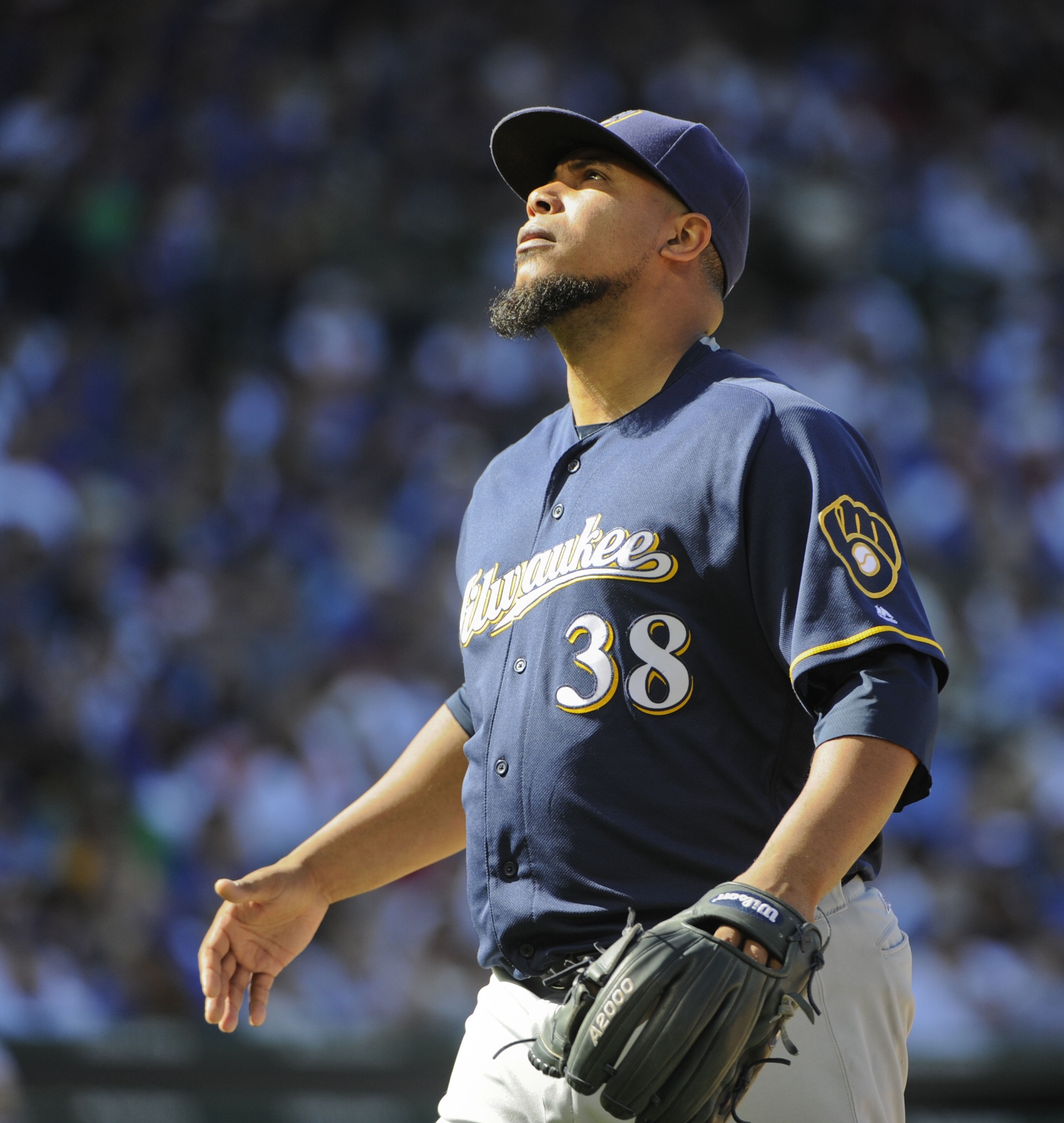In a sentence that I still can’t comprehend, Wily Peralta went toe-to-toe with a Cy Young contender to help the Brewers win the series against the Cubs.
Worst Play: Thanks to two second-inning singles — one of them off the bat of Peralta — the Brewers held a 2-0 advantage heading to the bottom of the sixth. Once there, however, Peralta ran into some trouble. Jason Heyard led off the frame with a single; Peralta induced a popup and a fielder’s choice, but the Cubs wouldn’t go down easily. Pinch-hitter Tommy La Stella lined a 1-1 slider into center field, where Domingo Santana misplayed it and allowed Javy Baez to score.
La Stella’s double (-.150) dropped the Brewers’ chances from 79.4 percent to 64.4 percent, the lowest they’d been since the third inning. Peralta would stop the bleeding, though, by coaxing Dexter Fowler into grounding out. That run remained his only fault, and three shutout innings from the bullpen later, Milwaukee would leave Chicago with the 3-1 victory.
Remember early-season Peralta? The one who lumbered his way to a 6.68 ERA and earned a one-way ticket to Colorado Springs? Evidently, that one has disappeared, and good riddance. Peralta must have fixed something down in Triple A, because he’s now made eight successful starts in August and September. The Brewers will re-evaluate and revamp their rotation in the offseason, and if Peralta sustains this momentum over his final two outings of the year, he’ll lock down a spot for 2017.
Best Play: Luckily for Peralta, his teammate at first gave his lead an extra cushion. With two outs in the eighth inning, Joe Maddon brought in a formidable righty to retire Chris Carter. In Triple A this year, Felix Pena struck out 31.6 percent of opposing batters; to this point in the majors, 10 of the 30 hitters to face him have gone down on strikes. But Carter made himself one of the other 20: After working his way to a full count, he turned on a slider and forced it over the wall in left.
Carter’s long ball (+.134) upped the Brewers’ win probability to 85.3 percent, its highest level of the day to that point. A 3-1 lead is quite different from a 2-1 lead; in the ninth inning, when two Cubs reached against Tyler Thornburg, that meant the winning run was at the plate instead of on base. That insurance run may have been what allowed Thornburg to bounce back — he fanned Anthony Rizzo and Kris Bryant on seven pitches combined.
As the Brewers gauge their outlook for 2017, they’ll have a hard time deciding what to do with Carter. He’ll go through arbitration this offseason and the next; they could decide to let him walk, as the Astros did in February. That seems unlikely, though, as Carter has put together a solid campaign (and he’s come on strong recently). Maybe he’ll depart via a trade, or maybe Milwaukee will keep him around to man first. If he can crack 36 homers and put up a .290 TAv next year, as he’s done in this one, he’ll have a job somewhere.
Trend to Watch: The obvious takeaway from Sunday’s game is Peralta’s continued excellence. Since returning to the rotation on August 9th, he’s worked his way to a 3.26 ERA over seven starts, with a 21.4 percent strikeout rate and 6.5 percent walk rate. But my colleague Seth Victor has already covered Peralta’s return, so I’d instead like to focus on Carter. He’s gone on a tear as of late, the causes of which I’ve had some difficulty discerning.
When the Brewers acquired Carter in the offseason, I noted he was a streaky hitter. He’s certainly shown that in 2016, following up a scorching April with subpar middle months that made his overall line mediocre. Then came September, in which he’s flipped the switch again. This month, he’s stormed his way to a .241/.348/.593 line; the resultant .942 OPS is his highest of any month this year.
Has he made any real changes in September? It’s hard to say. He’s certainly put the ball in the air more often — his ground ball rate this month has dipped to 22.9 percent. But that has occurred over a mere 16 games; it’s nowhere near a career low for him, or even a low this season. Likewise, his September hard contact rate of 42.9 percent is actually lower than his mark from May (44.3 percent), when he hit an unsightly .198/.235/.450. His strikeouts and walks line up with his overall season averages, so they don’t explain the explosion.
The answer might not be that Carter has broken out. Players in Carter’s mold, who prioritize the three true outcomes bring ups and downs. While we at BP Milwaukee — particularly me — like to analyze every minute happening on the Brew Crew, sometimes the best option is to sit back and enjoy it. Did Thornburg care whether or not Carter’s hot streak was sustainable when he had two runs supporting him instead of one? The visceral beauty of one of Carter’s long balls is enough for me.
Up Next: After a respite tonight, the Brewers head to Miller Park for their final homestand of the year, beginning with a three-game set against the Pirates. Matt Garza and Steven Brault kick things off on Tuesday at 7:10 CST. Then it’s Jimmy Nelson versus Chad Kuhl on Wednesday, and Chase Anderson facing Ryan Vogelsong in the Thursday finale.
